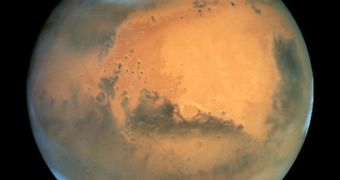A new “letter of intent” was recently signed in Washington DC, for the first time ever binding the Mars programs of the American space agency, NASA, and the European Space Agency (ESA) together. With this step completed, engineers can move to creating joint missions that could bring about a new understanding of the phenomena that go on in Mars' atmosphere, on its surface, and beneath the ground. The first joint mission is scheduled to take place in 2016, and it will feature a small orbiter being inserted in an orbit around the planet, the BBC News reports.
The program will then continue with a large ESA rover being landed on the surface of the planet around 2018, and perhaps by a large network of landers being deployed in 2010. According to initial plans, each of these stations would be smaller than NASA's recent Phoenix Mars Lander mission. However, utilizing more than one lander could lead to important discoveries, as they will all function within a single network, acting like a very large sensor.
But the main goal stated in the document is eventually developing capabilities that would allow the two agencies to design and construct a sample-return mission that would deliver Martian rocks to the Earth undamaged. One of the main reasons why the two parties decided to join efforts was the fact that their individual Mars exploration programs had come under attack, in the United States and the European Union, respectively.
With the new letter of intent, it may now be possible to maintain the one-mission-per-two-years program that was originally planned. The Mars Joint Exploration Initiative (Meji) was signed by NASA Administrator Charles Bolden, and ESA Director-General Jean-Jacques Dordain. The new document finally brings the collaboration closer to reality, and on a more formal footing.
“The important thing I think is that the member states have bought into the ideas; I'm not expecting any shocks,” the ESA Director of Science and Robotics, Professor David Southwood, says. He is the expert who developed the new strategy, together with colleague Dr. Ed Weiler, from NASA. The plans call for a 2016 launch of an orbiter that would study Martian gases, a 2018 mission that would see the deployment of both ESA and NASA rovers, as well as the proposed lander network, to be launched in 2010.

 14 DAY TRIAL //
14 DAY TRIAL //